Invasion of the pathogens
1/60
Earn XP
Description and Tags
Lecture 3
Name | Mastery | Learn | Test | Matching | Spaced |
|---|
No study sessions yet.
61 Terms
Not all plant associated micrboes are pathogenic!
All parts of the plant can support microbial flora
But mainly the leaves and roots that are best-studied niches
Microbes can occur inside plants without causing disease but this community is not well understood!
Why is studying plant-pathogen interaction important?
at least 25% of crop production lost to pathogenes
1 in 3 people malnourised
1 in 9 bed hungry
population unlikley to stabilise for at least 25 years
Climate chnage will affect food sercruit too
Example of a virus on crops
Potato late blight
Phytophthora infestans
resulted in deaths of millions
What studying plant-pathogen interaction also helps with?
Providing key insights into
physiology
development
molecular biology
of healthy plants
Where do plants harbour complex microbial communities
The Rhizosphere and Rhizoplane
Phyllosphere and Phylloplane
Endophytic: internal plant environment
Rhizosphere and Rhizoplane
The root habitat
Rhizoplane= microbes on the surface of the root
Rhizopshere= Rizoplane and micrones in immediate soil surrounding root
Provides rich growth envrionemetn for microbs
Plants exude >20% of their fixed carbon via the roots
How much photosynthate is given to the microbes IN RHIZOPHERE
20% of photosnythate leached out
(much more than at the roots)
Phyllosphere
Leaf niche envrionment
Phylloplane= leaf surface itself
Phyllosphere compared to Rhizosphere
much harsher conditions
fewer resources
over which microbes must compete
e.g only 1% of photosynthase it exuded for microbes (compared to 20% in the roots)
What do resident microbial population have to look out for?
Readily availible food supply and no deleterious effect on the plant so only look out for
microbes compete with each other for resources
cope with adverse envrionmental conditions
Amensalism
Presence of one microbe may diminish the ability of another to colonise
Amernsalism e.g1
Ethanol produced by yeasts
grow on grape skins
inhibits bacterial growth
Antibiosis
Amensalism e.g2
When fungal spores germinate, they leach carbon
But then reabsorb it
BUT
bacteria and yeasts van compete for it
this decreases the fungal growth
Compeition (esp. for Fe) may be fierce
Why competition for Fe fierce?
It is at low concentration in the soils
this is why e.g bacteria use the siderophores with high Fe affinity
Plant pathogen major trophic strategies (2)
Necrotrophs
Biotrophs
Necrotrophs
Only use substrate from dead tissue
Must kill host cells first
or use already dead material (saprotrophy)
can grow and reproduce away from a plant host
Biotrophs
Get material from living host tissue
must complete life cycle within living host
cannot be saprophytes
some cannot grow outside the host at all
(e.g viruses)
This makes them hard to cultivate on petri dish when find out about disease (see later)
Example of fungal biotrophs: powdery mildew fungus
developed specialised feeding strucutures within the host
haustorium
similar to arbuscle:
large surface area and host plasma membrane is not breached
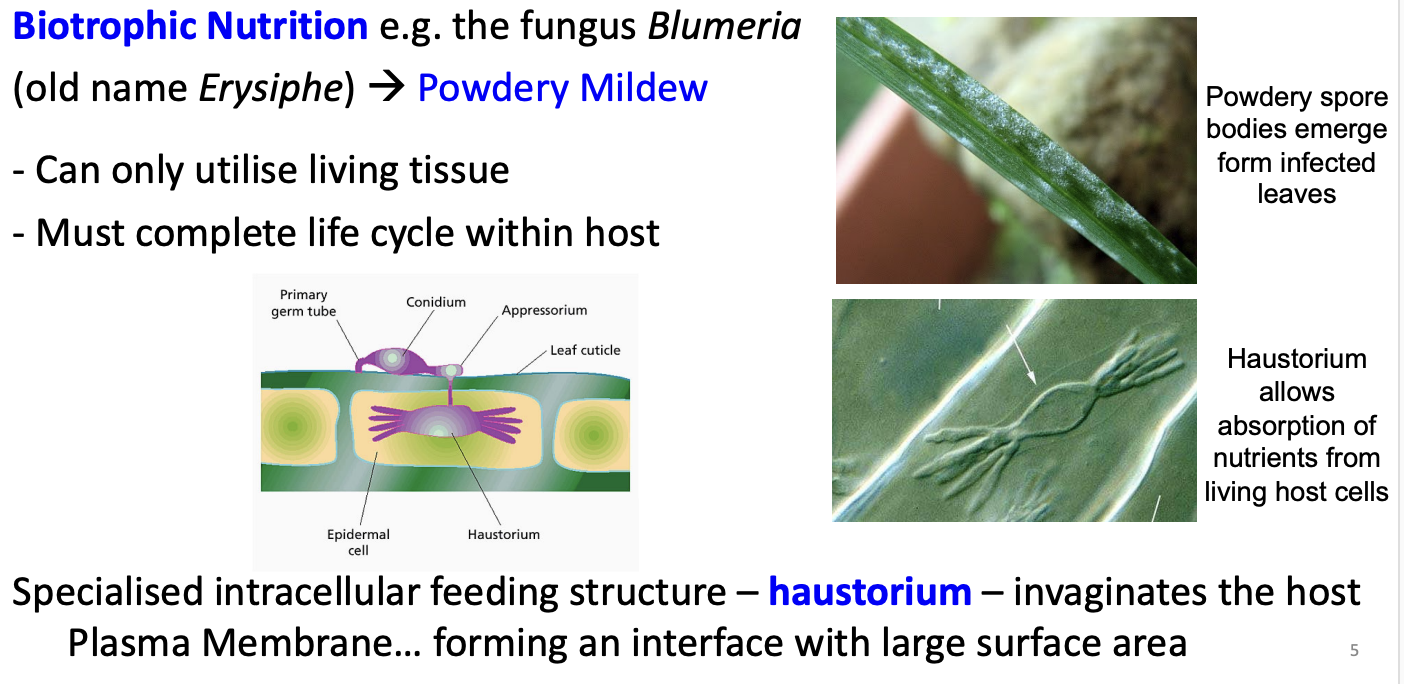
Hemi-biotrophy: P.infestans
Initial stage of infection involves extraction of nutrients from host cells through
simple haustoria (biotrophic)
then →
more aggressive necrotrophic stage
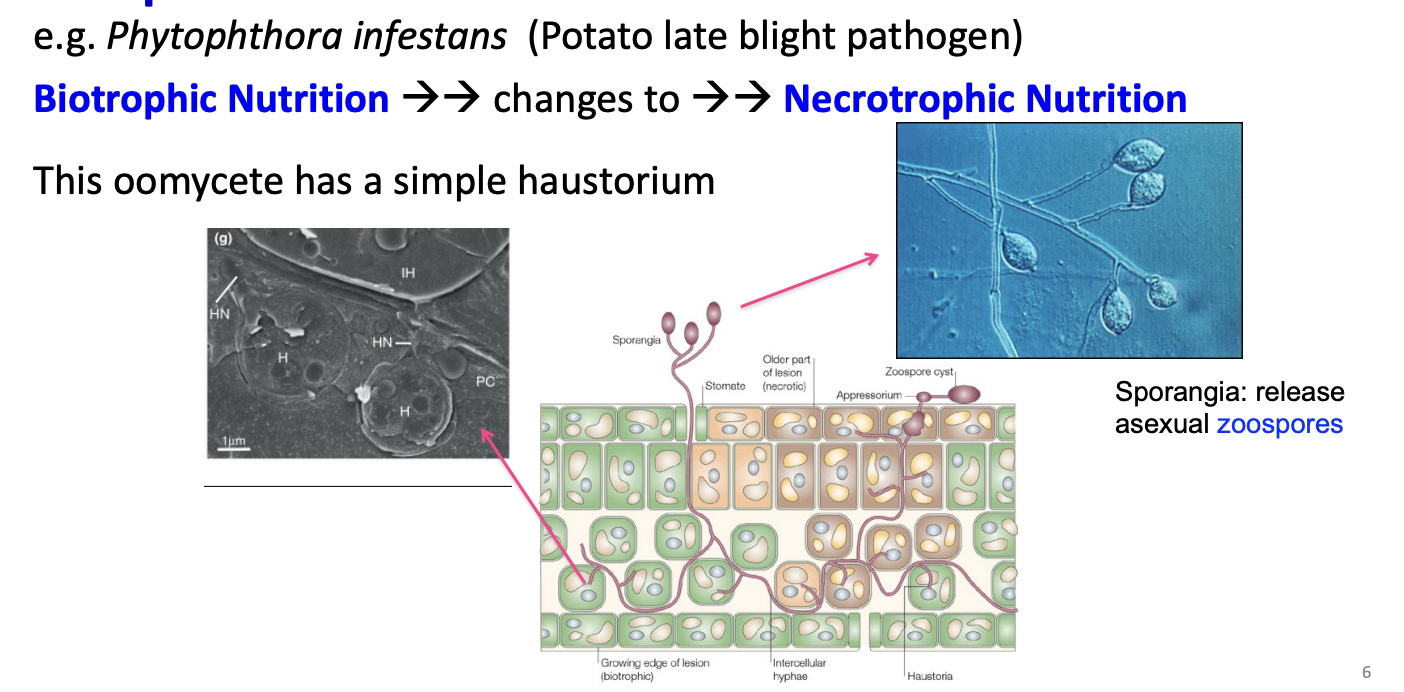
What are viruses
Obligate intracellular parasites
incapable of replicating outside the host cell
biotrophs
Difference of virus compared to other obligate intracellular parasites
no cells (non-cellular)
intracellular parasited
During replication:
not separated from the host cellcontents by lipid bilayer membrane
Not binary fission
instead:
assembly line type process
Virion
Virus particle containing:
viral nucleic acid
RNA or DNA
protein coat
protective
A fully assembled infectious virus is called a virion
Virion= the extracellular form of a virus
a fully formed infectious particle
Virus= encompasses its intracellular activties
Virions of most plant-infecting viruses
Shape:
Icosahedral
e.g Cucumber mosaic virus CMV
Rod shaped
e.g TMV
Nucleic acid:
relatively small RNA or DNA
Compared to bacteriophage
not as large cirons
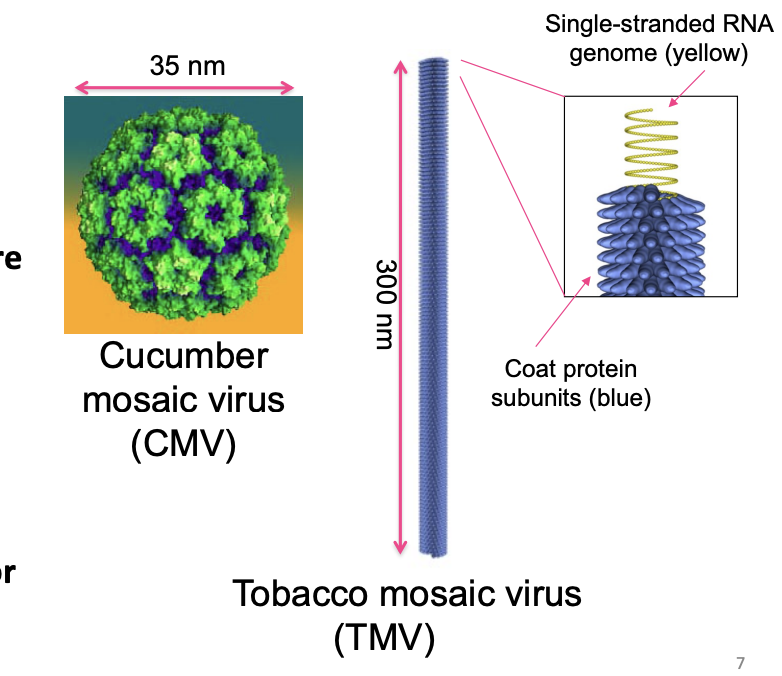
Virus structures
most plant-infecting viruses possess very simple particles
virions
comprise of coat protein molecules in simple geometric arrangement
e.g helical rods, icosahedra
surrounfing the viral nucleoid acid
Majority 70% of plant viruses have genome of RNA and the rest DNA
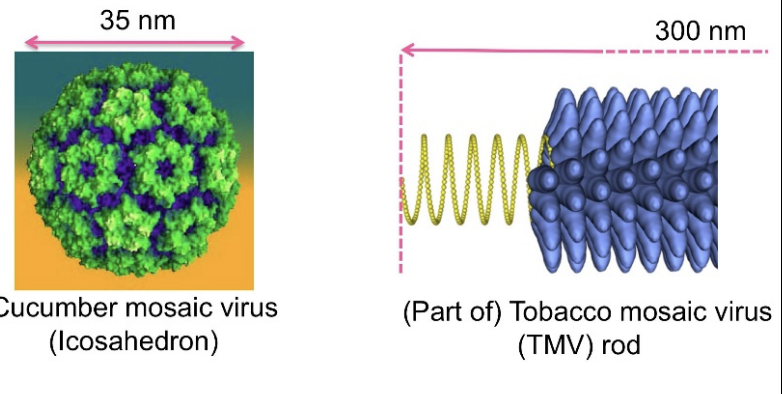
How do viruses spread through plants (short distance)
Symplastically
between cells
via plasmodesmata
Virus gating
virus modulate the pore diameter of plasmodesmata
why?
fascilitate its own movement using a virus-coded factor
‘movement protein’

Long distance travel
Via the phloem
same pattern as photosynthate transport
from source to sink
not passive
Mutations affecting virus travel
virus unable to exploit the phloem
remain trapped in the inoculation zone
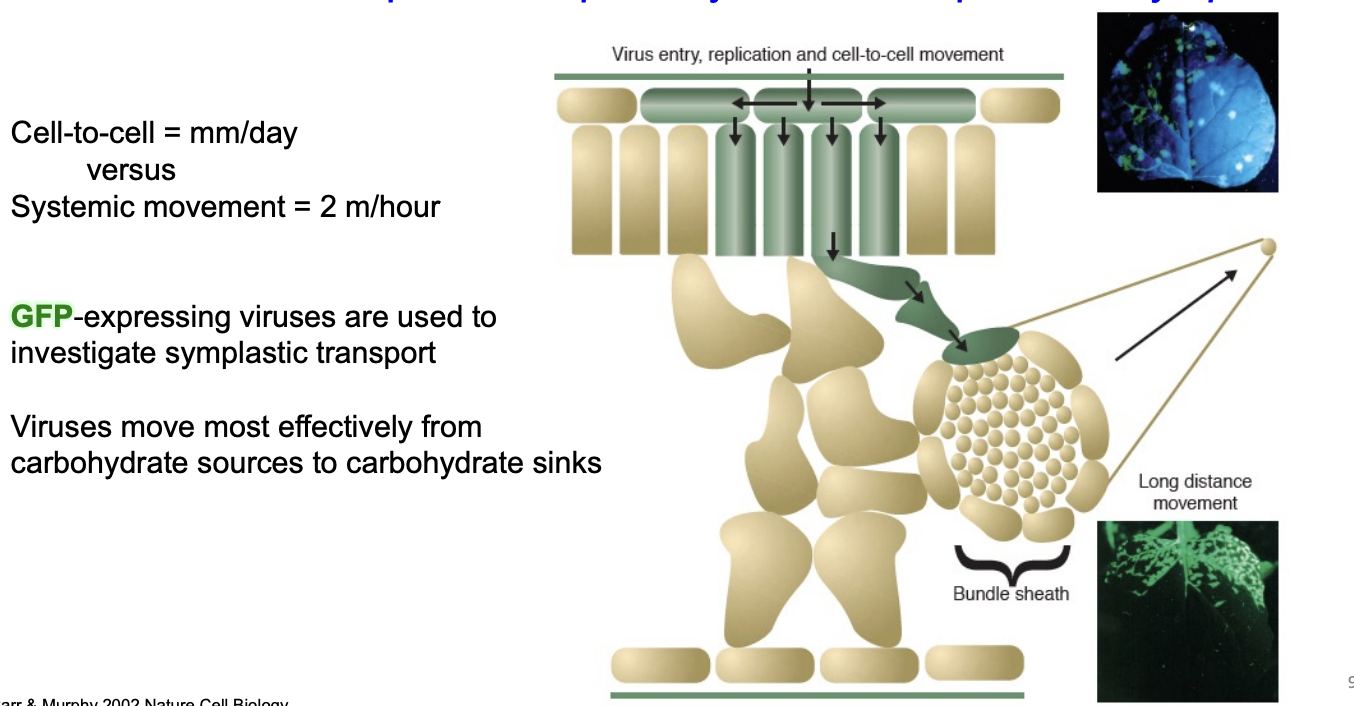
Unlike necrotrophic fungi and bacteria…
plant viruses rarely kill plants
but
can seriously reduce crop yield and quality
how?
due to the effects of specific viral gene products
NOT a simple effect of ‘viral load’
Infection and disease are facilitaded by…
pathogen-encoded Pathogenicity Determinants
Pathogen transmission mainly through
Other organisms
Insects snd other invertebrates act as vectors
How are plant viruses tranmitted?
60% of plant viruses are transmitted by insects
e.g aphids and whiteflies
What normally spreads plant bacteria
Beetles
e.g flea beetle transmises Pantoea stewartii to maize
What carries fungal spores
e.g Fusarium carried on surface of herbivores
insects
really useful coz the aphids do not kill the plant
good for biotrophic pathogensPlant -plant spread of bacteria

How do bacterial pathogens enter plants
Natural entry sites
wounds
stomata
lenticels
raised pores in stem of a woody plant that allows gas exchange
hydrathodes
‘water stomata
release of water droplets
plant-plant spread of bacteria
Aided by rain splash
bacteria lofted into clouds
might be transported long distances this way
Flagellate oomycete spores
e.g Phytophthora
attracted to opening
chemotropically
encyst
(swell up and lose flagella)
then, send germ tubes into the host
Why crucial for pathogens to adapt to natural opening
Race to aquire host nutrients
before their own run out
evolved to recognise natural opening
e.g Bean rust fungus, Uromyces appendiculates
How bean rust fungus grows into bean plant
germ tube makes contact with stoma
hyphal apex differentiates into infection strucutre
appressorium (bullbous strucutre)
This is positioned over the stomatal pore
Infection hypha grows from its lower surface into the sub-stomatal cavity
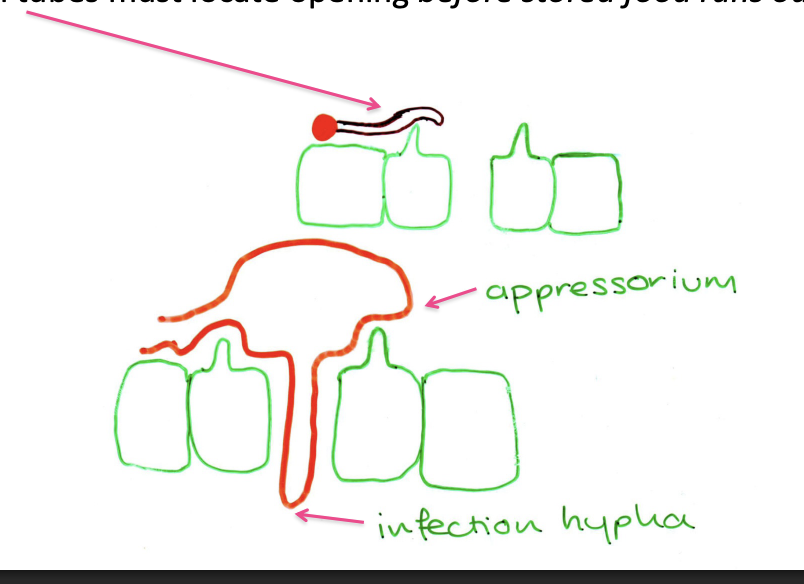
How does the germ tube recognise the stomata?
bean guard cells have ridges
mean height 0.487 micrometers
germintate spores on artificial surface
with ridges 0.5 micrometers high
form appressoria
If ridges are higher or lower: no appressoria formed
Overall: thigmotropic
can sense and react to changes in surface contour
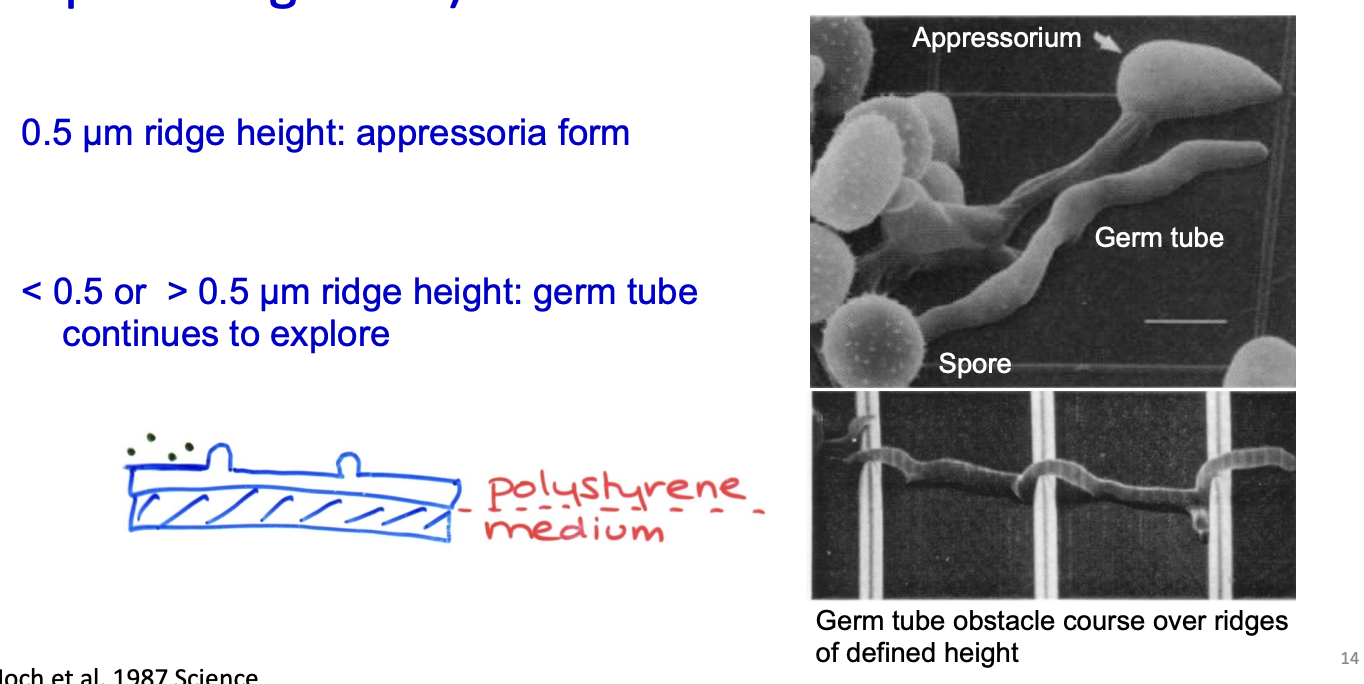
How can they recognise precise ridge height?
stretch-activated (mechnosensitive) cation channel
permeable to K+ and Ca2+
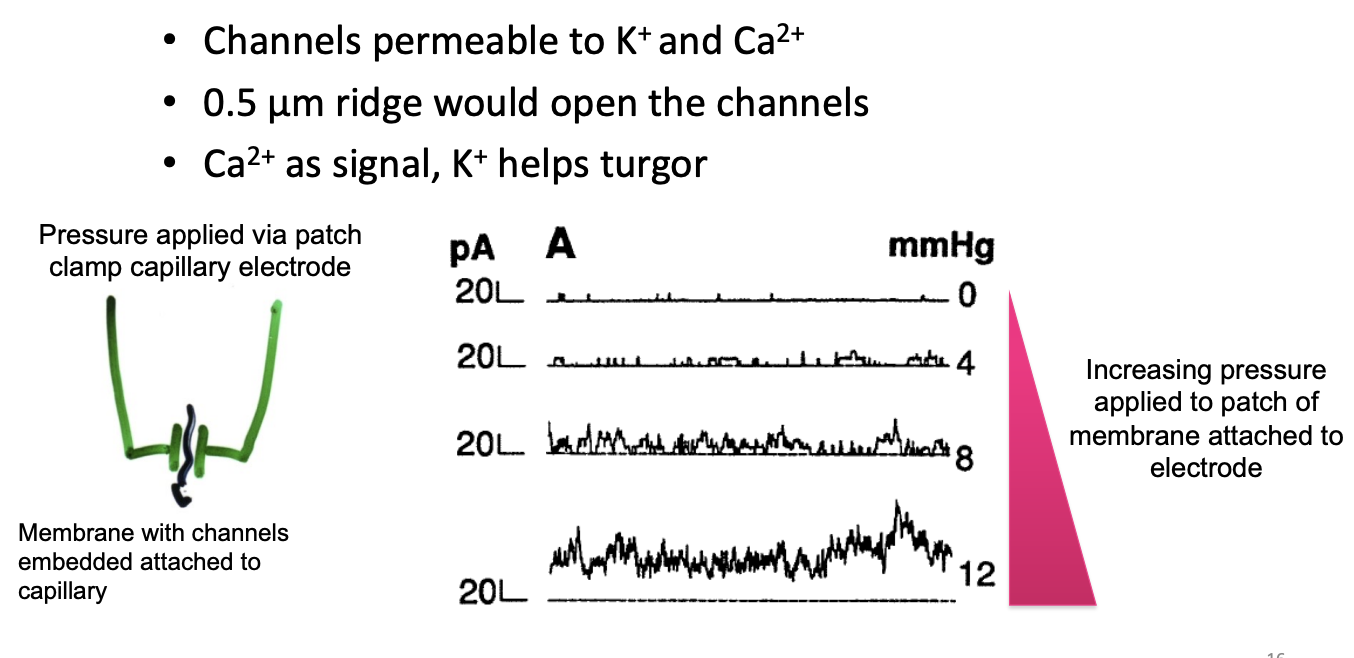
How discovered this
digested cell wall with enzymes
released apical portion of protoplast
exposed plasma membrane for electrophysiological analysis:
patch clamping revealed stretch mediated cation channel

How the channel works
blocked by extracellular Gd3+ at concentration that also inhibit appressorial differentiation
apex hits the ridge
range of membrane tensions of this hit opens the channel
nascent cell wall and membrane deform
apical region wall is flexible enough to allow sufficient deformation to affect stretch activated channels
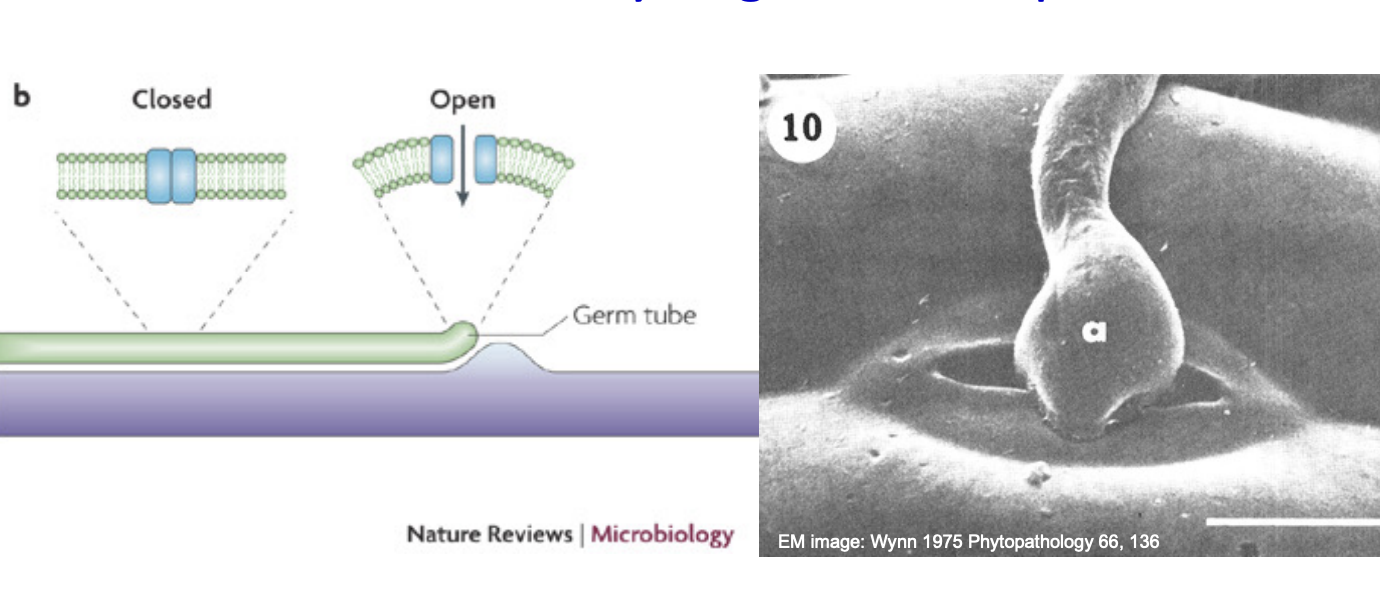
Role of Ca2+ influx
Could be a signal to differentiate
Role of K+ entry
Contribute to the solute potential
needed for appressorial swelling
Other ways to enter
enzymes
hydrostatic force
mainly together
What can do forced entry though plant cell wall
only filamentous fungi
How do they do this?
Some
require exoenzymes to break down cell wall
and its outer coatings of pectin and cutin
Others
produced specialised infections structures
e.g rice blast fungus
Magnaporthe oryzae
Case study: Magnaporthe oryzae: how penetrate rice plant
Mechanical penetration by an appressorium
punctures the plant surface
How does the fungus adhere to the surface
germ tube secretes hydrophobins from apex
amphipathetic peptides
reduce water loss
permit adhesion to hydrophobic surface
Overall process of forcing its way into plant tissue
appressorium forms
adheres to leaf surface with hydrophobins
3M glycerol accumlates to draw in water
generatures 8MPa pressure
but melanin keeps appressorium water-tight
pressure→ penetration hyphae formed at base of appressorium
What does penetration hyphae do
force exerted over a period of several hours
concentrated to narrow diameter hyphae
more pressure for penetration
Pressure is able to go through solid Mylar plastic
→Punches through

What does the melanin also do
protect against
UV
desiccation
Any enzyme involved too?
Cutinase esterase
encoded by CUT2 gene
helps to soften cuticle waxes
What are Woronin bodies role in thise?
Must have a crucial role because HEX1 (hex1delta) mutants cannot
penetrate via appressoria
survive nitrogen starvation
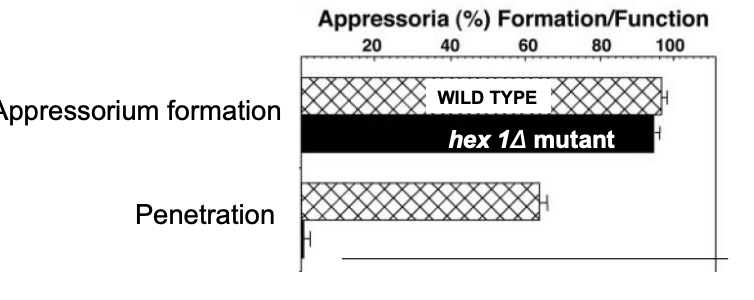
Pathogenicity determinants
specific genes that confer pathogenicity
Why would some fungi be pathogenic but some closely related be saptrotroph?
genes are not needed in vitro or native habitats for saprotroph
but essential for pathogenesis
How to identify pathogenicity determinants
knock out gene
insert antibiotic resistance gene
compare to original strain
e.g Moryzae (bean rust fugi)
MPG1 gene
encodes a secreted 15 kDa hydrophobin
knocked out:
germ tubes cannot attach to leaf
no pathogenicity
How do we identify pathogen, if the symptoms are similar?
isolate microbe from infection point
petri dish
inoculate into host of same species
but healthy
same symptoms appear
microbe must be the pathogen
re-isolate same microbe from diseased plant

Problems with this for biotrophic pathogens?
will not be able to survive on the petri dish without living plant there
also??
may be that the plant doesn’t have many symptoms?
because plant needs to stay alive for the pathogen to stay alive??